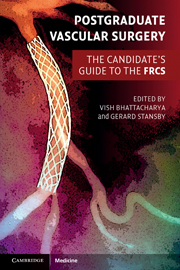Book contents
- Frontmatter
- Contents
- List of contributors
- Preface
- Section 1 Final FRCS vascular clinicals
- Section 2 Final FRCS vascular topics
- 1 Vascular risk factors and their management
- 2 Management of acute limb ischaemia
- 3 Chronic lower limb ischaemia, critical ischaemia and the diabetic foot
- 4 Endovascular and surgical options for peripheral revascularisation
- 5 Abdominal aortic aneurysms
- 6 Thoracic, thoracoabdominal and suprarenal aortic aneurysms
- 7 Aortic dissection
- 8 Popliteal artery aneurysms
- 9 Femoral artery aneurysms
- 10 Carotid, subclavian and vertebral disease
- 11 Diagnosis and management of thoracic outlet syndrome
- 12 Diagnosis and management of hyperhidrosis
- 13 Chronic mesenteric ischaemia
- 14 Acute ischaemic colitis
- 15 Vascular trauma
- 16 Indications and management of lower limb amputation
- 17 Leg swelling and lymphoedema
- 18 Varicose veins and chronic venous insufficiency
- 19 Management of deep vein thrombosis
- 20 Infection in vascular surgery
- 21 Vascular malformations
- 22 Vasospastic disorders and vasculitis
- 23 Critical care considerations and preoperative assessment for general and vascular surgery
- 24 Access surgery
- 25 Basic outline of solid organ transplantation
- Index
- References
8 - Popliteal artery aneurysms
- Frontmatter
- Contents
- List of contributors
- Preface
- Section 1 Final FRCS vascular clinicals
- Section 2 Final FRCS vascular topics
- 1 Vascular risk factors and their management
- 2 Management of acute limb ischaemia
- 3 Chronic lower limb ischaemia, critical ischaemia and the diabetic foot
- 4 Endovascular and surgical options for peripheral revascularisation
- 5 Abdominal aortic aneurysms
- 6 Thoracic, thoracoabdominal and suprarenal aortic aneurysms
- 7 Aortic dissection
- 8 Popliteal artery aneurysms
- 9 Femoral artery aneurysms
- 10 Carotid, subclavian and vertebral disease
- 11 Diagnosis and management of thoracic outlet syndrome
- 12 Diagnosis and management of hyperhidrosis
- 13 Chronic mesenteric ischaemia
- 14 Acute ischaemic colitis
- 15 Vascular trauma
- 16 Indications and management of lower limb amputation
- 17 Leg swelling and lymphoedema
- 18 Varicose veins and chronic venous insufficiency
- 19 Management of deep vein thrombosis
- 20 Infection in vascular surgery
- 21 Vascular malformations
- 22 Vasospastic disorders and vasculitis
- 23 Critical care considerations and preoperative assessment for general and vascular surgery
- 24 Access surgery
- 25 Basic outline of solid organ transplantation
- Index
- References
Summary
Key points
Popliteal artery aneurysm is the most common lower limb aneurysm
Lower limb arterial aneurysms rarely occur in isolation
The majority present either as an incidental finding or as lower limb ischaemia
Aneurysm rupture is rare, but life and limb threatening when it occurs
All symptomatic popliteal and femoral artery aneurysms should undergo repair
Asymptomatic popliteal artery aneurysms >2 cm in maximum diameter should be considered for elective repair
Asymptomatic femoral artery aneurysms >2.5 cm in maximum diameter should be considered for elective repair
Adequate imaging of the proximal and distal vasculature is vital for successful repair
Introduction
Popliteal artery aneurysms are the second most common peripheral arterial aneurysm and together with femoral artery aneurysms represent the vast majority of true lower limb arterial aneurysms. They frequently occur in association with aortic aneurysms and are often identified as an incidental finding during routine examination or radiological imaging. However, they may present with lower limb thromboembolism or rupture and thus their identification and subsequent management is vitally important to the patient's quality of life and life expectancy.
Pathophysiology
The majority of popliteal artery aneurysms (PAAs) develop secondary to a systemic atherosclerotic disease affecting the medial layer of the artery and are often associated with aneurysms elsewhere. In early retrospective studies in which PAAs were detected clinically or with the use of angiography rather than Duplex scanning, the incidence of PAAs in patients with aortic aneurysms was between 3.2 and 3.9%.
- Type
- Chapter
- Information
- Postgraduate Vascular SurgeryThe Candidate's Guide to the FRCS, pp. 115 - 122Publisher: Cambridge University PressPrint publication year: 2011



